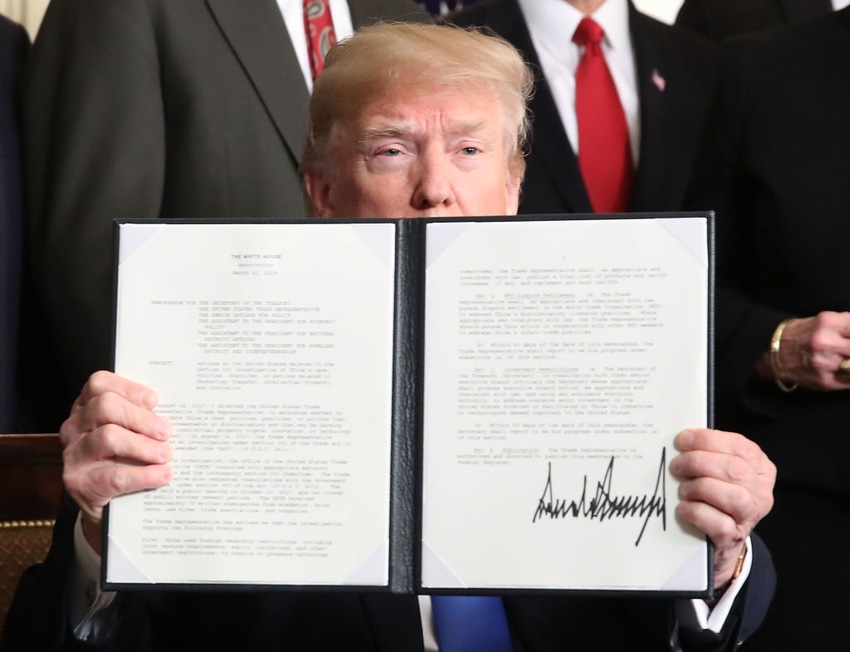Is there a method to Trump’s madness, stirring everything up and getting countries eager to negotiate in mere days?
March 29, 2018

Even if you’ve only been casually following the president’s trade threats and posturing, I bet you sat up and took notice when the Chinese announced intentions to put tariffs on $3 billion worth of U.S. grains and pork.
If sorting global trade has you concerned or puzzled, don’t feel bad. Experts who live this stuff are having to judge things they have not seen before.
What’s different now, of course, is President Trump. Unlike presidents before him, he is determined to get some better deals for America, to bring companies and jobs back to America and to do it more quickly than through normal diplomatic channels. And using aggressive tactics to throw people off balance, to spook them a bit and make them anxious to get to the bargaining table is certainly his style.
Trade is seldom totally free of political overtones but it is much more political now. Russia is strong-arming situations around the globe, North Korea has everyone on edge and China has made clear it desires both economic and military dominance of the world.
This means who’s in charge is important. Some of you know personally incoming Secretary of State Mike Pompeo from Kansas. He is a Tea Party conservative, a businessman and a former U.S. Army armor commander. John Bolton, a no-nonsense veteran of international affairs and not a member of the we’re-all-lawyers-we-can-negotiate-anything school of foreign policy, is running national security. Larry Kudlow, a dyed-in-the-wool free market economist, is Trump’s chief economics adviser. Kudlow considers tariffs as a negotiating tool only as a last resort. Trump obviously believes they can get results more quickly.
Tough negotiator
Pinning Trump down is not easy. He announced plans for blanket 25% tariffs on imported steel and 10% on aluminum. A bit later, he explained that countries that wanted to avoid those tariffs could negotiate trade agreements and they would be exempt while negotiations were going on.
Since Canada and Mexico were already negotiating with us regarding NAFTA, they would be exempt from the tariffs for now. Within days, additional countries were added to the exemption list. It’s not clear whether any country will end up paying the steel or aluminum tariff, although some will face quotas.
Then turning to the real target, the administration announced plans for tariffs on $60 billion worth of Chinese goods. As would be expected, China responded by announcing intentions to slap tariffs on $3 billion worth of American grains and pork.
Veteran watchers noted right away the huge disparity between $60 billion and $3 billion. The Chinese went through the motions but they need our grains and pork. So negotiators got busy during the weekend and beyond. Note that neither China nor the U.S. has actually levied tariffs on anything yet. With the world situation in flux and ambitious plans, China wants a trade war no more than we do.
Trump is blending his own version of Teddy Roosevelt’s “Speak softly but carry a big stick” and Reagan’s “Peace Through Strength,”—without the “speak softly” part—as his foreign and trade policy. The $700 billion boost to our military budget can’t have escaped notice, either.
Will KORUS set the stage?
Somewhere off to the side, the administration completed a re-negotiation of the free trade agreement with South Korea. Remember when Trump pulled out of TPP and started re-negotiation on NAFTA, his team promised a string of bilateral trade agreements? This is evidently the first one.
You could hear a sharp intake of breath among cattlemen all over the country when he mentioned re-working the deal with South Korea. I hope never again to see hundreds of thousands of any country’s citizens demonstrating in the streets against beef provisions in a trade agreement. But thankfully, the re-work doesn’t address any changes regarding our number two export customer for U.S. beef. However, it does make the “chicken tax” of 25% on imported pickups permanent.
So is there a method to Trump’s madness, stirring everything up and getting countries eager to negotiate in mere days? It’s too soon to tell. What’s certain is that while everyone has talked about China’s ignoring and flouting of international trade rules for decades, no one has done anything much about it. The WTO is extremely slow.
Trump has his first tranche of tax cuts in place, immigration is stalled as part of the Democrats’ 2018 election strategy and fixing China’s little red wagon was a key Trump campaign promise. I believe I said somewhere during the campaign that Trump would be like having a bull in the china shop compared to Obama’s “don’t-offend-anyone-but-conservatives” policy.
But while all this was going on, North Korea’s Kim Yong Un was in China for “unscheduled meetings”—doesn’t that make you shudder—and a face-to-face meeting is scheduled with President Trump soon. Unthinkable just weeks ago.
We may have a do-nothing Senate and a do-little House, but we have a bull rush style White House. Agriculture has an uncomfortable seat during this ride because we export all over the world and are vulnerable targets. People in foreign countries need our products as necessities of life and we need the revenue, with margins much tighter than the industrial world and low commodity prices. But for now, it seems a deep seat in the saddle and patience with an unpredictable bronc is advisable.
NAFTA
As for NAFTA, it is possible the pressure of the calendar may finally be telling on negotiations. The next round begins April 8 in Washington and could last 10 days. U.S. Trade Representative Robert Lighthizer revealed at the end of the last round that he hoped to have a deal complete and the Congressional six-month consultation period completed by roughly year’s end.
That would, most likely, require the U.S. to back off its most controversial proposals in the upcoming session and settle for moderate improvements. Otherwise, with upcoming elections in Mexico, America and two Canadian provinces, the jig would be up until 2019. Trade Promotion Authority for President Trump expires June 30, 2018.
The difficult automotive portion has made some progress, with the Canadians suggesting counting the intellectual property of the software and chips in cars as part of the American content where possible. Other proposals address the disparity in wages paid Mexican workers vs. the other countries and collective bargaining for Mexican workers. The idea is to not only raise Mexican wages but reduce the incentive for American companies to move there.
Stay tuned. This dance is far from over.
Steve Dittmer is a longtime industry commentator and principal of the Agribusiness Freedom Foundation.
About the Author(s)
You May Also Like





